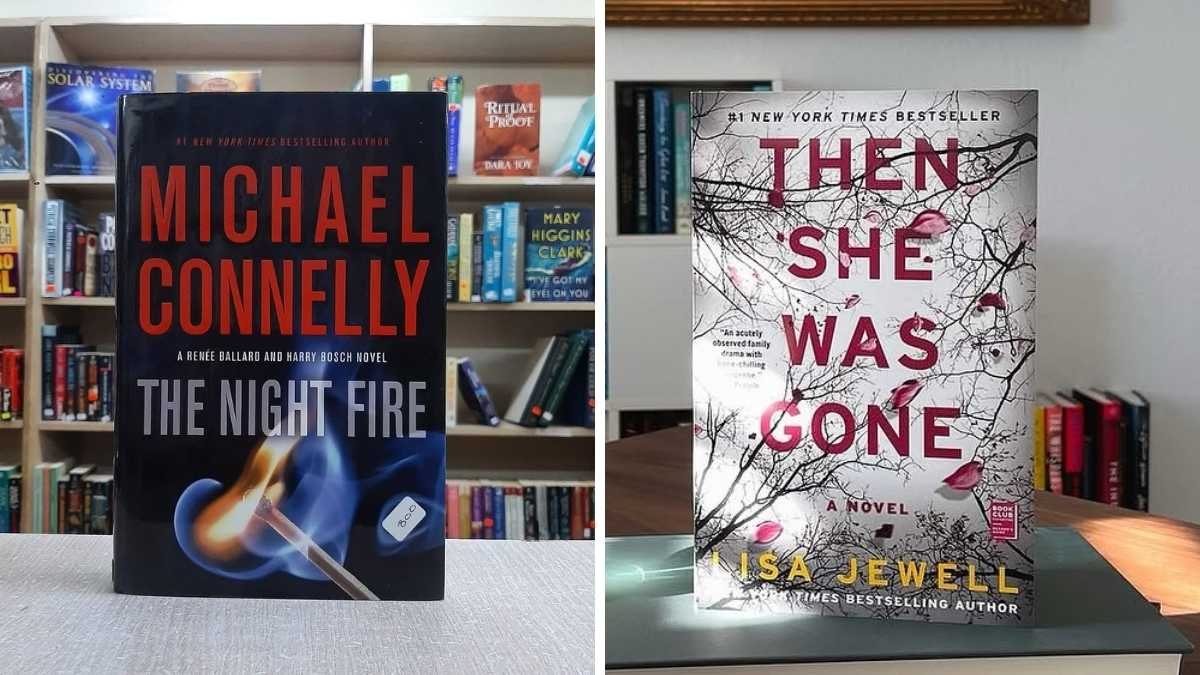
If you’ve ever found yourself dog-earring a page at 2 a.m. because just one more chapter turned into three, mystery novels are your kryptonite.
The thrill of piecing together clues, the racing heart when the plot pivots, and the glorious “aha!” moment—these books are engineered to keep you guessing.
But some mysteries stand out for their razor-sharp twists, the kind that make you clutch your coffee mug and shout, “Wait, what?!” Here are 16 mind-bending reads that’ll have you second-guessing every character… even the houseplants.
1. “Gone Girl” by Gillian Flynn

“A marriage so twisted, even the happy endings are lies.”
Nick and Amy Dunne’s fairy tale romance crashes into a nightmare when Amy disappears on their fifth wedding anniversary. Is she a victim, a liar, or something far darker? Flynn’s genius lies in her unreliable dual perspectives—Nick’s sarcastic, self-pitying narration vs. Amy’s slick, Cool Girl diary entries. The “twist” isn’t just the reveal of Amy’s manipulation; it’s the chilling gaslighting of the reader. By the end, you’ll question whether true love exists… or if it’s just a performance.
Why it works: Flynn exposes the rot beneath “perfect” marriages, forcing readers to confront uncomfortable truths about privilege and pathology. The third-act shocker? So audacious it sparked debates for years.
2. “The Silent Patient” by Alex Michaelides

“A woman’s silence. A husband’s lies. A therapist’s obsession.”
Alicia Berenson shoots her husband five times in the face but never speaks again. Therapist Theo Faber becomes obsessed with cracking her mind, only to unravel his ethics in the process. Michaelides weaves a psychological thriller where the unspoken becomes the ultimate weapon. The final twist? A gut-punch that recontextualizes every page you’ve read—think Fight Club meets I Know What You Did Last Summer.
Key hook: The novel’s unreliable narrator isn’t just Alicia—it’s you, the reader. Every assumption you make about guilt and innocence is flipped.
3. “The Girl on the Train” by Paula Hawkins

“A Functional Drunkard might be the only one who sees the truth.”
Rachel, a recovering alcoholic who commutes past a seemingly perfect suburban couple daily, witnesses something disturbing—or does she? Hawkins’ fragmented timeline and shifting perspectives (Rachel, the wife, the husband) build a labyrinthine plot where memory is the weakest link. The infamous “twist” isn’t the only bombshell; the book’s critique of gaslighting and societal disregard for women’s narratives packs a wallop.
Why readers rave: The unreliable narration forces you to revisit clues with fresh eyes. The “aha” moment? Less a revelation and more a slow-burning unraveling of identity.
4. “The Turn of the Screw” by Henry James

“Are the ghosts real… or is the governess losing her mind?”
A young governess arrives at a remote English estate to care for two angelic children. But the property is haunted by the spirits of a deceased valet and governess—or is it? James’s novella is a masterclass in ambiguity. The final line (“Miles! Miles! Say you never, never will!“) leaves readers debating for decades: Are the children possessed, or is the governess a delusional neurotic?
Literary twist: The ambiguity is the twist. James forces you to confront your own biases—is horror external, or internal? A psychological thriller before the genre existed.
5. “The Secret History” by Donna Tartt

“A group of Classics students. A dark pact. A body in the meadow.”
Five elite college students bond over their shared obsession with Greek philosophy… until a ritualistic murder goes wrong. Tartt’s prose is lush, but her storytelling is a slow-drip poison. The killer is revealed early—it’s the “why” and the “how” that spiral into moral quicksand. The final chapters? A haunting meditation on guilt and the corrosive power of secrets.
Why it lingers: Tartt forces you to sympathize with deeply flawed characters. The real question isn’t “Who did it?” but “How far would you go for belonging?”
6. “Sharp Objects” by Gillian Flynn

“A hometown so suffocating, even the wounds fester in the shadows.”
Reporter Camille Preaker is dragged back to her small, claustrophobic hometown to cover the murders of two young girls. But returning means facing her venomous, hypochondriac mother and her mysterious half-sister, who’s more than just a little strange. As Camille digs into the case, she discovers eerie similarities between the victims and her traumatic past. The story unravels like a frayed nerve, with Flynn’s razor-sharp prose dissecting the rot beneath family facades. The twist? It’s not just about the killer—it’s about how the past claws its way back to consume you. By the end, you’ll question whether healing is even possible after certain scars.
Why it lingers: Flynn transforms a murder mystery into a gut-wrenching exploration of family dysfunction. The final reveal isn’t just shocking—it’s a mirror held up to the darkest corners of human psychology.
7. “The Girl with the Dragon Tattoo” by Stieg Larsson

“A missing girl. A web of secrets. A hacker with nothing to lose.”
Journalist Mikael Blomkvist is hired to investigate the decades-old disappearance of Harriet Vanger, a wealthy Swedish heiress. Teaming up with Lisbeth Salander, a brilliant but deeply damaged hacker, they uncover a labyrinth of corruption, violence, and family betrayals. The deeper they dig, the more dangerous the game becomes. Larsson’s masterpiece isn’t just about solving a cold case—it’s about exposing the rot of privilege and the monstrous acts hidden behind closed doors. The twist? The truth is darker, more twisted, and far more satisfying than you could imagine.
Why it’s iconic: Larsson created one of fiction’s most unforgettable characters in Lisbeth. Her blend of vulnerability and lethal intelligence drives the narrative forward, making this not just a mystery but a cathartic takedown of misogyny and greed.
8. “Big Little Lies” by Liane Moriarty

“Suburban perfection with a knife-edge underneath.”
Three seemingly ordinary mothers—Madeline, Celeste, and Jane—become entangled in a web of secrets when a school fundraiser ends in tragedy. As their lives unravel, dark truths about marriage, motherhood, and the lies we tell to survive come to light. The story jumps between timelines, dropping breadcrumbs that hint at a catastrophic event. The twist? It’s not just about the death—it’s about the lies that lead to it and the fractures in these women’s lives that made it inevitable. By the end, you’ll see how even the most polished facades can shatter.
Why it resonates: Moriarty’s genius lies in her ability to turn ordinary suburban drama into a psychological thriller. The final reveal isn’t just shocking—it’s a haunting commentary on the fragility of identity.
9. “Behind Closed Doors” by B.A. Paris

“A perfect couple. A perfect lie.”
Jack and Grace are the epitome of a perfect couple—wealthy, charming, and inseparable. But when a young woman named Ruiz moves in next door, she becomes increasingly paranoid about Grace’s behavior. As the story unfolds, Ruiz’s suspicions grow, and the line between reality and delusion blurs. The twist? The truth about Jack and Grace’s marriage is far more sinister than anything Ruiz could have imagined. Paris keeps you guessing until the very last page, questioning whether anyone can truly know their neighbors-or their sanity.
Why it thrills: Paris masterfully plays with perception and reality. The final reveal isn’t just a shock—it’s a punch to the gut that forces you to reevaluate everything you thought you knew.
10. “Shutter Island” by Dennis Lehane

“A missing patient. A haunted island. A mind on the edge.”
Two U.S. Marshals arrive at Shutter Island, a remote mental institution, to investigate the disappearance of a patient. As they delve deeper into the case, they uncover a web of lies, experiments, and horrors that blur the line between reality and delusion. The atmosphere is suffocating, and the tension builds to a breaking point. The twist? It’s not just about the missing patient—it’s about the Marshals’ grip on reality. By the end, you’ll question everything you thought was true.
Why it’s unforgettable: Lehane’s novel is a masterclass in psychological horror. The final revelation isn’t just shocking—it’s a haunting exploration of memory, identity, and the fragility of the human mind.
11. “We’re All Lying” by Marie Still

“A family reunion where the ghosts of the past come knocking.”
Five siblings return to their childhood home for the funeral of their estranged father. As they clean out the house, they uncover a series of letters that reveal their father was being blackmailed. But the letters are dated after his death, and the blackmailer is still out there. The story is told from multiple perspectives, with each sibling hiding their secrets. The twist? It’s not just about the blackmailer—it’s about the lies the siblings have been telling themselves and each other. By the end, you’ll question whether any family can truly know one another.
Why it’s gripping: It still masterfully weaves a tale of family dysfunction and secrets. The final reveal isn’t just a shock—it’s a mirror held up to the fragility of family bonds.
12. “The Stranger on the Train” by Abbie Taylor

“A chance meeting that spirals into a deadly game.”
Rachel, a young woman on a train journey, witnesses a man strangling his wife. She contacts the police, but they don’t believe her. Then she meets Tom, a charming stranger who seems to know more than he should. As Rachel gets drawn into Tom’s world, she realizes she’s in over her head. The twist? The truth about Tom is more shocking than anything Rachel could have imagined. By the end, you’ll question who you can trust on a train… or in life.
Why it’s thrilling: Taylor creates a tense atmosphere and a cast of characters that keep you guessing. The final reveal isn’t just a shock—it’s a punch to the gut.
13. “The Woman in White” by Wilkie Collins

“A moonlit encounter that leads to a web of secrets and madness.”
On a moonlit London night, art teacher Walter Hartwright meets Anne Catherick, a beautiful, terrified woman dressed entirely in white. She claims to be the victim of a terrible injustice and entreats Walter to help her clear her name. As Walter gets drawn into Anne’s world, he uncovers a plot of bigamy, identity theft, and madness. The twist? The truth about Anne’s identity is more shocking than anything Walter could have imagined. By the end, you’ll question the very nature of identity and trust.
Why it’s iconic: Collins’ novel is a masterclass in Victorian suspense. The final reveal isn’t just a shock—it’s a haunting exploration of the duality of human nature.
14. “The Thursday Murder Club” by Richard Osman

“A group of retired folks who solve murders… and have a few secrets of their own.”
A group of retirees at a posh retirement community form a murder club to discuss fictional murders. But when a local man is found dead, they decide to investigate. As they dig deeper, they uncover a web of secrets and lies. The twist? One of the members of the club is hiding a dark past. By the end, you’ll question whether anyone is truly retired from crime.
Why it’s beloved: Osman’s novel is a delightful blend of humor and suspense. The final reveal isn’t just a shock—it’s a heartwarming reminder that age doesn’t diminish curiosity.
15. “Then She Was Gone” by Lisa Jewell

“A mother’s search for her missing daughter that uncovers secrets she never imagined.”
When Alice’s daughter disappears, she becomes obsessed with finding her. As she digs deeper, she uncovers a web of secrets that lead her to question everything she thought she knew about her family. The twist? The truth about her daughter’s disappearance is darker than Alice could have imagined. By the end, you’ll question the line between love and obsession.
Why it’s compelling: Jewell’s novel is a heart-wrenching exploration of motherhood and loss. The final reveal isn’t just a shock—it’s a haunting reminder of the darkness that can lurk beneath the surface of ordinary lives.
16. “The Night Fire” by Michael Connelly

“A fire that burns secrets, and a detective who can’t let go.”
Detective Renee Ballard and Harry Bosch team up to investigate a fire that reveals a decades-old murder. As they dig deeper, they uncover a web of corruption and betrayal that reaches the highest levels of power. The twist? The truth about the murder is more shocking than anything they could have imagined. By the end, you’ll question the very nature of justice and the price of uncovering the truth.
Why it’s gripping: Connelly’s novel is a masterclass in suspense. The final reveal isn’t just a shock—it’s a chilling exploration of the human psyche and the lengths people will go to protect their secrets.







